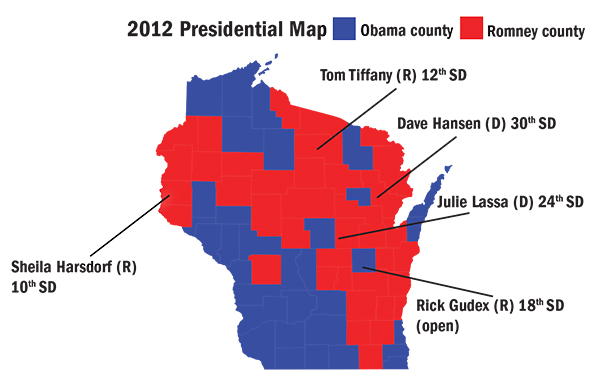With eight months to go before the November election, it’s a good time to take a look at the upcoming fight between Democrats and Republicans for control of the Wisconsin Senate. Republicans control both houses of the legislature in the Badger State, but Democrats believe they have an outside shot at regaining control of the “upper house” this November.
There are several factors that influence elections in every two-year cycle. Such factors include the quality of the candidates running in districts that are truly competitive as well as the outcome of the top-of-the-ticket presidential election when Senate elections occur during a presidential election year. Here are a few statistics and political landscape considerations to watch as the 2016 legislative elections unfold:
GOP controls state Senate 19-14: With a five-seat GOP majority, Democrats will need a net three-seat pick-up to regain a majority. This may not seem like an overly steep hill to climb, but this number doesn’t tell the whole story. Only half of the 33-member state Senate will run in 2016, or 16 of the 33 seats. This cuts the playing field in half. With eight Democrats and eight Republicans on the ballot this November, Democrats must hold all of their seats and pick up three of the eight Republican seats to claim their majority.
Five of 16 seats look competitive today: A close review of the “average” Democrat or Republican election performance of all 16 Senate seats on the November ballot would suggest that five of the 16 districts could be competitive this fall. Four of the five districts fall into the “lean Republican” or “lean Democrat” classifications; these districts include those with Sens. Tiffany, Gudex, Lassa and Hansen. And one district is classified “swing,” which is Sen. Harsdorf’s district. All five of these Senate seats will be targeted in 2016. A “lean Democrat” or “lean Republican” seat means the district favors one party over the other by a margin of 52.1 to 54.9 percent. A “swing” seat performs in a range of 48 to 52 percent.
Wide open presidential election cycle: Will Wisconsin be a truly competitive “swing state” in the 2016 presidential election like it was in 2000 during the Gore vs. Bush election and in 2004 with Bush vs. Kerry? Or will Wisconsin resemble the one-sided elections won by Barack Obama in 2008 during Obama vs. McCain as well as in 2012 with Obama vs. Romney? These five targeted seats could easily be influenced by which way the political winds are blowing in November. If the presidential race is close, incumbents would likely have the advantage. If it’s not close one way or the other, these districts could flip from one party to the other.
Seven times in a row: Democrats have carried Wisconsin in presidential elections seven times in a row. The last time the GOP won was 1984, when Reagan defeated Mondale. Will this trend continue in 2016? A comfortable win by Democrats at the top of the ticket could be the difference in any of these five targeted districts.
Given the unpredictable and, in some cases, surprising results in the presidential primaries this year, it’s too early to predict which way Wisconsin voters will fall in 2016. Whichever direction Wisconsin voters do take, it could matter a great deal to candidates in these five seats.
Sheila Harsdorf (R) – Senate District 10

| McCain 2008: |
49% |
|
| Walker 2010: |
59% |
|
| Romney 2012: |
52.5% |
|
| Walker 2014: |
57.9% |
|
| Partisan average: |
52% GOP |
|
| District classification: |
Swing |
|
Tom Tiffany (R) – Senate District 12

| McCain 2008: |
48% |
|
| Walker 2010: |
59% |
|
| Romney 2012: |
53% |
|
| Walker 2014: |
61.6% |
|
| Partisan average: |
52.8% GOP |
|
| District classification: |
Lean GOP |
|
Ruck Gudex (R) – Senate District 18 (open)

| McCain 2008: |
48% |
|
| Walker 2010: |
58% |
|
| Romney 2012: |
49.9% |
|
| Walker 2014: |
57.5% |
|
| Partisan average: |
52.6% GOP |
|
| District classification: |
Lean GOP |
|
Julie Lassa (D) – Senate District 24

| McCain 2008: |
41% |
|
| Walker 2010: |
53% |
|
| Romney 2012: |
46.8% |
|
| Walker 2014: |
57.7% |
|
| Partisan average: |
53.1% Dem |
|
| District classification: |
Lean Dem |
|
Dave Hansen (D) – Senate District 30

| McCain 2008: |
43% |
|
| Walker 2010: |
55% |
|
| Romney 2012: |
47.1% |
|
| Walker 2014: |
55.6% |
|
| Partisan average: |
52.1% Dem |
|
| District classification: |
Lean Dem |
|

Joe Murray is Director of Political and Governmental Affairs for the WRA.